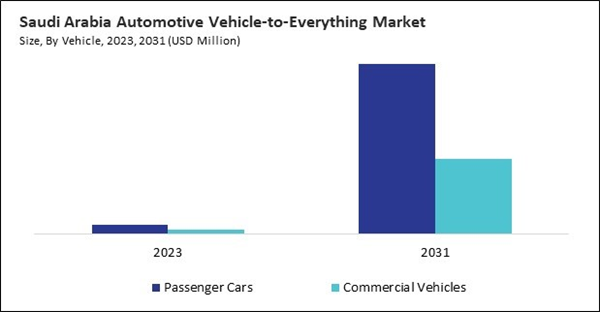The Brazil market dominated the LAMEA Automotive Vehicle-to-Everything Market by country in 2023, and is expected to continue to be a dominant market till 2031; thereby, achieving a market value of $526.1 million by 2031. The Argentina market is registering a CAGR of 46.9% during 2024-2031. Additionally, the UAE market would witness a CAGR of 43.8% during 2024-2031.
Beyond tracking and maintenance, V2X significantly improves route planning and logistics efficiency, helping fleet operators overcome traffic congestion, unpredictable road conditions, and delivery delays. AI-driven V2X navigation systems evaluate real-time traffic information to enhance route optimization, thereby minimizing travel duration and petroleum expenditure. Companies like Amazon leverage V2X and AI-driven algorithms to enhance last-mile delivery, ensuring packages reach customers faster while lowering emissions. Additionally, platooning technology allows trucks to travel in synchronized formations, reducing aerodynamic drag and boosting fuel efficiency. V2X also plays a crucial role in regulatory compliance and driver safety, with ride-hailing companies like Uber and Lyft using connected vehicle data to monitor driver behavior and enforce safe driving standards. As smart logistics and intelligent fleet management evolve, V2X will remain a key technology in creating cost-effective, sustainable, and efficient transportation systems.
The rising popularity of Mobility-as-a-Service (MaaS) is revolutionizing urban transportation by integrating multiple transport options - such as ride-sharing, public transit, and micro-mobility - into a unified platform. This shift is powered by V2X technology, which enables real-time ride coordination, seamless public transport integration, and dynamic route optimization. By leveraging V2X-based data exchange, MaaS providers like Uber, Lyft, and Moovit can efficiently allocate fleets, reduce wait times, and enhance passenger convenience.
Brazil is leading the V2X adoption curve in Latin America, driven by rising demand for connected and electric vehicles (EVs). As the dominant automotive sector within the region, Brazil is implementing sophisticated transportation technologies to improve urban mobility and mitigate traffic congestion. According to the Brazilian Electric Vehicle Association (ABVE), sales of electric vehicles in Brazil nearly doubled in 2023, reaching 93,927 units in December, compared to 49,245 in 2022. The anticipated EV sales in 2024 are projected to exceed 150,000 units, reinforcing the country’s transition toward intelligent and sustainable mobility solutions.
Through initiatives like "Plano Nacional de Mobilidade Urbana" (National Urban Mobility Plan), the Brazilian government is actively promoting the integration of connected vehicles into its transportation infrastructure. Automakers and infrastructure developers are responding by investing in advanced V2X cybersecurity measures to protect V2I and V2V communication systems from potential cyber threats. As LAMEA countries progress toward connected mobility, securing V2X communication networks will remain a top priority for governments, automakers, and technology providers, ensuring the safety, efficiency, and reliability of the region’s smart transportation systems.
List of Key Companies Profiled
- Infineon Technologies AG
- Qualcomm Incorporated (Qualcomm Technologies, Inc.)
- NXP Semiconductors N.V.
- Continental AG
- DENSO CORPORATION
- Harman International Industries, Inc. (Samsung Electronics Co., Ltd.)
- Lear Corporation
- Aptiv PLC
- Robert Bosch GmbH
- TomTom N.V.
Market Report Segmentation
By Device
- Onboard Unit
- Roadside Unit
By Connectivity
- Cellular
- DSRC
By Vehicle
- Passenger Cars
- Commercial Vehicles
By Communication
- Vehicle-to-Vehicle (V2V)
- Vehicle-to-Infrastructure (V2I)
- Vehicle-to-Pedestrian (V2P)
- Vehicle-to-Network (V2N)
- Vehicle-to-Home (V2H)
- Vehicle-to-Grid (V2G)
By Country
- Brazil
- Argentina
- UAE
- Saudi Arabia
- South Africa
- Nigeria
- Rest of LAMEA
Table of Contents
Companies Mentioned
- Infineon Technologies AG
- Qualcomm Incorporated (Qualcomm Technologies, Inc.)
- NXP Semiconductors N.V.
- Continental AG
- DENSO CORPORATION
- Harman International Industries, Inc. (Samsung Electronics Co., Ltd.)
- Lear Corporation
- Aptiv PLC
- Robert Bosch GmbH
- TomTom N.V.
Methodology

LOADING...









